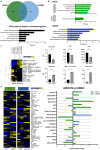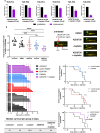Functionally-instructed modifiers of response to ATR inhibition in experimental glioma
- PMID: 38475864
- PMCID: PMC10935927
- DOI: 10.1186/s13046-024-02995-z
Functionally-instructed modifiers of response to ATR inhibition in experimental glioma
Abstract
Background: The DNA damage response (DDR) is a physiological network preventing malignant transformation, e.g. by halting cell cycle progression upon DNA damage detection and promoting DNA repair. Glioblastoma are incurable primary tumors of the nervous system and DDR dysregulation contributes to acquired treatment resistance. Therefore, DDR targeting is a promising therapeutic anti-glioma strategy. Here, we investigated Ataxia telangiectasia and Rad3 related (ATR) inhibition (ATRi) and functionally-instructed combination therapies involving ATRi in experimental glioma.
Methods: We used acute cytotoxicity to identify treatment efficacy as well as RNAseq and DigiWest protein profiling to characterize ATRi-induced modulations within the molecular network in glioma cells. Genome-wide CRISPR/Cas9 functional genomic screens and subsequent validation with functionally-instructed compounds and selected shRNA-based silencing were employed to discover and investigate molecular targets modifying response to ATRi in glioma cell lines in vitro, in primary cultures ex vivo and in zebrafish and murine models in vivo.
Results: ATRi monotherapy displays anti-glioma efficacy in vitro and ex vivo and modulates the molecular network. We discovered molecular targets by genome-wide CRISPR/Cas9 loss-of-function and activation screens that enhance therapeutic ATRi effects. We validated selected druggable targets by a customized drug library and functional assays in vitro, ex vivo and in vivo.
Conclusion: In conclusion, our study leads to the identification of novel combination therapies involving ATRi that could inform future preclinical studies and early phase clinical trials.
Keywords: Combination therapies; DNA damage response pathway; DigiWest; Functional genomics.
© 2024. The Author(s).
Conflict of interest statement
Gh.T. has served on advisory boards (Bayer, Boehringer Ingelheim, CureVac Miltenyi Biomedicine, Novocure), as a consultant (Bayer, Boehringer Ingelheim, CureVac), as steering committee member in non-interventional trials (Bayer, Novocure), as a speaker (Novocure, Servier), and financial compensation for all these activities was provided as institutional funding to the University Hospital Tübingen. The other authors do not have anything to disclose.
Figures




Similar articles
-
Genome-wide CRISPR-Cas9 screens identify BCL family members as modulators of response to regorafenib in experimental glioma.Neuro Oncol. 2025 May 15;27(4):916-931. doi: 10.1093/neuonc/noae278. Neuro Oncol. 2025. PMID: 39756423 Free PMC article.
-
Evaluation of [18F]-ATRi as PET tracer for in vivo imaging of ATR in mouse models of brain cancer.Nucl Med Biol. 2017 May;48:9-15. doi: 10.1016/j.nucmedbio.2017.01.002. Epub 2017 Jan 16. Nucl Med Biol. 2017. PMID: 28157626 Free PMC article.
-
WEE1 inhibitor and ataxia telangiectasia and RAD3-related inhibitor trigger stimulator of interferon gene-dependent immune response and enhance tumor treatment efficacy through programmed death-ligand 1 blockade.Cancer Sci. 2021 Nov;112(11):4444-4456. doi: 10.1111/cas.15108. Epub 2021 Aug 31. Cancer Sci. 2021. PMID: 34382294 Free PMC article.
-
Recent Advances in Synergistic Antitumor Effects Exploited from the Inhibition of Ataxia Telangiectasia and RAD3-Related Protein Kinase (ATR).Molecules. 2022 Apr 12;27(8):2491. doi: 10.3390/molecules27082491. Molecules. 2022. PMID: 35458687 Free PMC article. Review.
-
Targeting ATR in cancer medicine.Curr Probl Cancer. 2017 Jul-Aug;41(4):302-315. doi: 10.1016/j.currproblcancer.2017.05.002. Epub 2017 May 17. Curr Probl Cancer. 2017. PMID: 28662958 Review.
Cited by
-
Genome-wide CRISPR-Cas9 screens identify BCL family members as modulators of response to regorafenib in experimental glioma.Neuro Oncol. 2025 May 15;27(4):916-931. doi: 10.1093/neuonc/noae278. Neuro Oncol. 2025. PMID: 39756423 Free PMC article.
References
MeSH terms
Substances
LinkOut - more resources
Full Text Sources
Molecular Biology Databases
Research Materials
Miscellaneous

